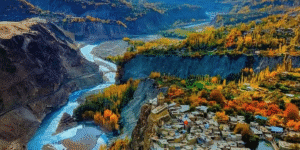Table of Contents
ToggleAbout Astore Markhor- What is it?
As Pakistanis, we know that Markhor is considered the National animal of Pakistan. Astore Markhor is one of the breeds of Markhor. Its scientific name is Capra falconeri. It is found significantly in the region of Gilgit Baltistan, Pakistan.
Its enormous, spiraling, twisting horns, which vary in shape depending on the subspecies, are arguably the most striking in the goat family.
Visit Gilgit Baltistan in Winters
This region, Gilgit Baltistan, is enriched with many mountains. It is the dry area of Pakistan, the best place for these species to live.
This breed of Markhor is found in the Astore Valley, so it is named after this beauty. This informational guide will give you amazing facts about this Markhor species, and it won’t disappoint you!
A Sub-Specie of Which Markhor?
The Astore and Kashmir Markhor are the two subspecies of the flare-horned markhor. With its adaption to hilly environments, the flare-horned Markhor usually lives in scrub forests with scarce oak (Quercus ilex), pine (Pinus gerardiana), and juniper (Juniperus macropoda) woods. They are found in Pakistan’s northern regions, between 700 and 4000 meters above sea level, in Chitral, Kohistan, Azad Kashmir, and Gilgit-Baltistan.
These habitat requirements have restricted their range to mountains below altitudes of 2200 m in winter. However, these animals are restricted to tiny, dispersed groups of 22–100 individuals found in Gilgit–Baltistan along the Indus River and its tributaries.
Status of Astore Markhor in Different Regions
In Pakistan, the Astor Markhor is regarded as endangered and is listed as Near Threatened internationally. Like many other species, this species is also threatened to be nearly extinct. Several writers estimate the population of flare-horned markhors to be about 4500 individuals, with the highest concentrations found in Gilgit-Baltistan (1500), Khyber-Pakhtunkhwa (2959), and Azad Jammu Kashmir.
Throughout their range of distribution, all markhor sub-species are threatened by several factors, such as
- Competition from livestock for food resources,
- With an increasing human population,
- Deforestation,
- Poaching,
- Illegal hunting,
- Genetic isolation brought on by a decrease in connectivity between sub-populations,
- Hybridization,
- Habitat fragmentation,
- A decrease in specialized habitats for forage,
- A low rate of reproduction,
Significant Features of Astore Markhor
| Features | Values |
| Species Name | Astore Markhor |
| Scientific Name | Capra falconeri |
| IUCN Conservation Status | Endangered (due to habitat loss, hunting, and competition with livestock) |
| Habitat | Found in mountainous regions of Northern Pakistan, specifically the Astore Valley and surrounding areas |
| Physical Characteristics | Large wild goat with twisted, spiral horns (can grow up to 1.5 meters in males), brown to blackish coat, lighter underbelly |
| Sexual Dimorphism | Males are larger, with long, twisting horns and a prominent beard, while females are smaller with shorter, less twisted horns |
| Diet | Herbivorous; primarily grazes on grasses, leaves, and shrubs |
| Behavior | Solitary or forms small groups; males tend to be more solitary except during mating season |
| Reproductive Season | Males are larger, with long, twisting horns and a prominent beard, while females are smaller, with shorter, less twisted horns |
| Conservation Efforts | Protected in national parks and conservation reserves; hunting is regulated through special permits |
| Significance | A symbol of strength and national pride in Pakistan; also the national animal of Pakistan |
| Cultural Importance | Featured in local folklore and traditions; historically valued for their horns in trade and hunting |
| Threats | Poaching, habitat destruction due to deforestation, competition with domestic livestock, and climate change |
| Adaptations | Highly adapted to rugged, mountainous terrain; capable of navigating steep slopes and cliffs with ease |
Astore Markhor- Mating Habits
Markhor’s mating system is polygynous, meaning that males mate with numerous females throughout each breeding season. When they mate in the winter, the males battle each other by lunging, locking horns, and trying to knock the other off balance. During the 135–170-day gestation period, one or two children, seldom three, are typically born.
Early in life, the young are completely formed from birth and can walk. After six months, mothers nurse and protect their children, and they start to become more independent. Between the ages of 18 and 36 months, young male and female Markhor reach reproductive maturity. This is how the population of this Markhor breed increases.
Discussion on Their Population
The current populations are widely dispersed, with a rough density of 0.13 animals per km2 in the whole GB region. However, the density is higher in certain catchments, such as Doyan (0.9 animals/km2), DMT (0.6 animals/km2), Kargah, and Bunji (0.5 animals/km2). The remainder of the catchments have 0.1 animals/km2.
Better habitat conditions and the habitats’ proximity to other valleys with more numerous markhor populations may cause the increased density in the Doyan, DMT, Bunji, and Kargah valleys. Doyan and DMT populations are mingled with Bunji populations, while Kargah and Khanbari populations are mixed. Moreover, the literature corroborates this, reporting plentiful populations in the Kargah valley.
Areas with Abundant Astor Markhor Populations
In Gilgit-Baltistan, trophy hunting operations were initiated in areas with high populations of Astor Markhor in the late 1990s. The locals in these valleys take a proactive approach to conservation, focusing mostly on trophy markhor hunting. This allows the community to receive 80% of license fees to improve the well-being of the affected villages.
The locals have been convinced to take care of animal populations, particularly those of the highly valued Markhor species, due to the socioeconomic benefits derived from trophy hunting.

Trophy Hunting of Capra falconeri
Eight of the fifteen CCHAs in GB with markhor populations—Kargah, Sakwar-Jutial-Barmas, Harmosh-Sassi, Skandarabad, Bunji, DMT, Doyan, and SKB—now allow trophy hunting for C. f. Falconeri.
Following the tenth CITES meeting, trophy hunting for C. f. Falconeri was permitted in northern Pakistan in 1997 to support community-based conservation projects that support the conservation of endangered species. Additionally, four markhor trophies are taken yearly in Great Britain, often one animal per catchment spaced one to several years apart.
How to manage things in such a way that these creatures don’t get existential threats?
There is significant worry about the structural viability of the C. f. Falconeri population, particularly in valleys where trophy hunting is practiced. In regions where the Markhor dwells in dispersed subpopulations that are geographically isolated from one another, such as Chitral and Gilgit-Baltistan, where the tiny populations are isolated, the effects of trophy hunting may be harmful.
Harvesting one adult male every year would not be a major cause for worry in a location like the KPK, Gilgit-Baltistan, which surrounds Chitral Gol National Park, where huge herds inhabit continuous habitats. However, taking one animal from a small catchment with a tiny, isolated population might jeopardize the population’s structure and the purpose of the trophy hunting program.
The Best Time to Hunt Astor Markhor?
Pakistan has an abundant Astor markhor hunting season. The hunt can be scheduled anytime between October 15 and April 30. Numerous experts advise that the winter months, when heavy snowfall drives animals into valleys and the rut occurs, are the ideal times to hunt. However, there are many other considerations.
Conclusion
A magnificent and critically endangered animal, the Astor Markhor is indigenous to Pakistan and is a subspecies of the Markhor. Its distinguishing features are its unique spiraling horns and affinity for hilly settings in the Gilgit-Baltistan area.
Despite implementing conservation initiatives, the Astore Markhor is still threatened by habitat loss, poaching, and climate change. Its existence depends on improving habitat conservation, stopping poaching, encouraging sustainable travel, spreading awareness, and funding scientific studies.
Implementing these actions to safeguard this iconic species can guarantee its survival in Pakistan’s varied habitats.
FAQs about Astore Markhor
What is the scientific name for Astore Markhor?
Capra falconeri falconeri is the scientific name of this Himalayan Brown Bear.
Is Markhor halal or haram?
According to Islam, as this creature category belongs to herbivores, this Markhor species is considered Halal.
Is Astore Markhor only in Pakistan?
The topmost habitats of this species of markhor are Turkmenistan, Tajikistan, Afghanistan, Pakistan, India, Jammu and Kashmir, and Uzbekistan.
What is the Astore Markhor habitat?
They prefer areas with steep-incline rocky structures, high-altitude carpets of flora, and very dense vegetation.
Is it illegal to hunt markhor in Pakistan?
No, male Markhor can be hunted, but females and young markhor are prohibited.
What is markhor called in English?
They are called screw horns or screw-horned goats.







